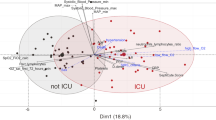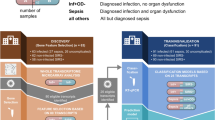Abstract
Septic syndroms and the associated perturbation of immune homeo — stasis represent a major health problem in intensive care settings. Aim of our development is a diagnostic tool for monitoring the post-operative host response to assess the risk of early infectious complications. The diagnostic application of an established RNA-biomarker panel from whole blood for septic patients, measured on a qPCR platform, will be extended towards immunosuppressed post-transplant patients.
Similar content being viewed by others
Literatur
Reinhart K, Bauer M, Riedemann NC et al. (2012) New approaches to sepsis: molecular diagnostics and biomarkers. Clin Microbiol Rev 25:609–634
Ramilo O, Allman W, Chung W et al. (2005) Gene expression patterns in blood leukocytes discriminate patients with acute infections. Blood 109:2066–2077
WO 2008107114 A3: Control genes for the normalization of gene expression analysis data, patent application id PCT/EP2008/001582
WO 2012120026 A1: Method for identifying a subset of polynucleotides from an initial set of polynucleotides corresponding to the human genome for the in vitro determination of the severity of the host response of a patient, patent application id PCT/EP2012/053870
Tian Z, Palmer N, Schmid P et al. (2009) A practical platform for blood biomarker study by using global gene expression profiling of peripheral whole blood. PLoS One 4:e5157
Debey S, Zander T, Brors B et al. (2006) A highly standardized, robust, and cost-effective method for genome-wide transcriptome analysis of peripheral blood applicable to largescale clinical trials. Genomics 87:653–664
Vandesompele J, De Preter K, Pattyn F et al. (2002) Accurate normalization of real-time quantitative RT-PCR data by geometric averaging of multiple internal control genes. Genome Biol 3:research0034.1–0034.11
Kim SI, Kim YJ, Jun YH et al. (2009) Epidemiology and risk factors for bacteremia in 144 consecutive living-donor liver transplant recipients. Yonsei Med J 50:112–121
Bert F, Larroque B, Paugam-Burtz C et al. (2010) Microbial epidemiology and outcome of bloodstream infections in liver transplant recipients: an analysis of 259 episodes. Liver Transpl 16:393–401
Deng MC, Eisen HJ, Mehra MR et al. (2006) Noninvasive discrimination of rejection in cardiac allograft recipients using gene expression profiling. Am J Transplant 6:150–160
R Development Core Team (2006) R: a language and environment for statistical computing. R Foundation for Statistical Computing, Wien. ISBN: 3-900051-07-0, www.R-project.org
Author information
Authors and Affiliations
Corresponding author
Rights and permissions
About this article
Cite this article
Felsmann, K., Möller, E., Rauchfuß, F. et al. Genexpressionsdiagnostik zur Erkennung früher postoperativer Risiken. Biospektrum 19, 768–770 (2013). https://doi.org/10.1007/s12268-013-0391-0
Published:
Issue Date:
DOI: https://doi.org/10.1007/s12268-013-0391-0




